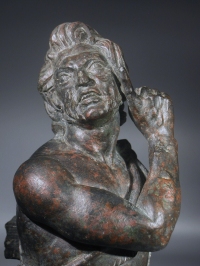Graeco-Roman bronze Satyr.
2nd century BC-1stcentury AD
H. 15cm (6 in.)
Originally attachment of a chariot or furniture. Missing left arm. Very fine smooth green patina with reddish-brown spots.
New
Sold
Ex. German Private Collection; The Collection of Charles W. Newhall, III, MD USA.
The Satyr is emerging from acanthus in spiral motion, with his head lifted and turned to the right and his right hand pointed near his left cheek. He wears a panther skin, bound across the chest and tied at his left shoulder. The Satyr is modeled with wild and lively features of the head and a powerful muscular body. The head with big locks of hair and short beard on the cheeks, framing the face with large open eyes, arched nose and big mouth with wide fleshy lips, open to reveal the upper row of teeth.
The expressive face and the powerful body with the lively spiral movement are typical to the Hellenistic style.
Cf. True, M., and Hamma, K., Collection of Barbara and Lawrence Fleischman, 1994, pp. 258-259, no. 130.
True, M., and Hamma, K., A Passion for Antiquities. Ancient Art from the Collection of Barbara and Lawrence Fleischman, Exh. cat., The J. Paul Getty Museum in association with Cleveland Museum of Art, California, 1994
Back to top

|
|
 Click on any image to enlarge it.
Click on any image to enlarge it.
   
|
